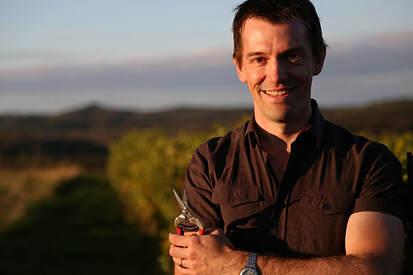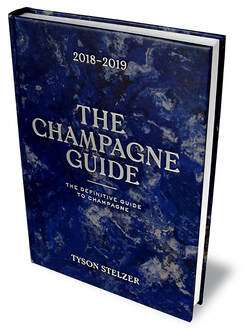 Tyson Stelzer, Author, The Champagne Guide. Tyson Stelzer, Author, The Champagne Guide. GK: How did you become involved in the Wine and Champagne business? It was quite an extraordinary change of life that took me from a high school science master on Queensland’s Gold Coast fifteen years ago to the privilege of ultimately bringing the title of International Wine Communicator of the Year to Australia for the first time. At the age of 26, I had a growing ambition to write about wine, to tell the stories of the remarkable people and places that create this amazing beverage. And so, I set about writing my first wine book. I had a great concept; I knew there was an interested audience, so all I had to do was find a publisher. I proudly sent my pitch to every worthy publisher I could find, eager to launch a career as a wine writer! The response was unanimously deflating: ‘If you’re not a celebrity or an established author, we’re not interested.’ My writing career was doomed before it even began, but then I put my mind to forging another way. I laid out my first book on a borrowed desktop computer in my back room late at night. And before I knew it, I’d spent $5,000 on printing, and I was a self-published author! It was to be the first of thirteen wine books that I would self-publish, and it’s only been in the past three years that I’ve made the switch to working with a big publisher to open up international distribution opportunities. GK: Where did your vision to create the Champagne Guide originate? My interest in champagne was sparked during a family holiday visit to the region in 2010 and the realization that there was a need for an up-to-date guide in English. My favorite English champagne writers were retiring, and I wished that I could find up-to-date reviews in print. My first Champagne Guide was a succinct (176 page) book, but it created a much bigger stir than I ever expected. Within months of its publication, I was flying to London to be awarded International Champagne Writer of the Year in The Louis Roederer International Wine Writers’ Awards 2011. Six years on, I am currently releasing the fifth edition of The Champagne Guide. I’m frequently asked why I write more about champagne than anything else. It goes without saying that I love the wine, the place, and its people. I am thrilled by the challenge of unraveling what is probably the most complex wine style in the world, and I love the chase of discovering the real story behind the wines of its most guarded brands. Of all the world’s most famous and celebrated wines, less is written about champagne than any other. There is no beverage that speaks of celebration more universally than champagne, traversing cultures and languages to toast everything from christenings to coronations. Of Europe’s most highly prized benchmarks, none is more readily available and more affordable across the globe than champagne. There is much to celebrate, much that champagne’s eager drinkers are thirsty to learn, and I count it a great privilege to bring the real stories of this enchanting place to the world, but there’s a more important reason. Wine is about connecting people, about bringing people together and building relationships. And champagne does that better than any other wine. GK: Tell us about the research you had to accomplish to produce the Champagne Guide. There is something of a ‘thrill of the chase’ in researching champagne quite unlike any other wine. For me, the key to communicating with champagne is to unearth and demystify the people, the places and the processes that define every cuvée as unique. To understand the soils, the slopes, the climate, the grapes, the wine making, the aging and the personalities of each of the characters who craft every detail of this long and convoluted process. The challenge and the chase come because volunteering these details is not traditionally the way of the Champenoise. Every year I fight my way through the froth and bubble of the most over marketed wine region in the world. These are a guarded folk, and their promotions and communication have long circled around glamorous estates, illustrious histories, elaborate packaging, fabricated prestige, gushing rhetoric, stratospheric pricing, flirtations with royalty, sightings with supermodels, or websites with more animated glitz that you can point a cursor at! These trite campaigns do little to communicate what makes a house style or a particular cuvée unique. My readers don’t have time or finances to taste every champagne to decide what they’ll drink, so it is my responsibility to communicate what every cuvée tastes, smells and feels like so they can quickly decide if might suit their taste and prove worthy of their investment. It has taken years and countless visits to build relationships with the key houses and growers and for them to build the confidence to confide in me the real stories of their vineyards, their cuveries, and their cellars, to unlock the minute details that make their cuvées unique. And over the seven years since this has been my focus, it’s been encouraging to see the region beginning to open up. Back labels, web sites, and brochures are much more informative now than they have ever been, as houses appreciate that an ever more educated world of champagne lovers is thirsty to lap up this detail. GK: You are promoting Tasmania, how does Tasmania fit into your story? I have long loved Tasmanian sparkling, though I haven’t lived there since I was four years old, I was born in Australia’s little, southerly island state, I’ve returned there in recent times to film harvest for a television series, and I’ve watched its wine industry come of age in recent years. After champagne became a special focus, I was approached by James Halliday to write the sparkling reviews for his Australian Wine Companion, the most important annual Australian wine guide. In recent years, I have also published my own Australian Sparkling Report, a comprehensive review of 500 Australian sparkling wines of all kinds, free to download at www.tysonstelzer.com/articles. Across my tastings year after year, Tasmania confidently reaffirms its place as Australia’s sparkling capital. Australia’s isolated, cool, southerly island state is privileged to a marginal and challenging climate well suited to premium sparkling growing. Its significance at the pinnacle of Australian sparkling cannot be overstated. Most parts of mainland Australia are warmer and sunnier than northern Europe and consequently not well suited to producing great white or rosé sparkling wines. Climate change is only serving to exacerbate this situation. Tasmania ascends to ever greater sparkling heights with each passing year. In Australian capital city wine show history, no sparkling wine has ever eclipsed all still and fortified wines to win champion wine of show. Until now. Over the past two years, Tasmanian sparklings have been awarded the highest recognition in top Australian wine shows not once but four times, winning the trophies for the Best Wine of Show in The National Wine Show in Canberra, The Sydney Royal Wine Show, The Royal Queensland Wine Show and The National Cool Climate Wine Show. Tasmanian sparkling has finally come of age, and in the wake of such tremendous domestic success, it’s time for Australia to unveil its finest fizz on the world stage. This is the reason that I am traveling to New York this month to not only launch the new edition of The Champagne Guide but to showcase an invitation- only selection of my favorite Tasmanian sparkling producers, both the famous names and the smallest boutiques. For more information about Tyson Stelzer please visit his website at www.winepress.com.au ~ by Diana DeLucia
0 Comments
Your comment will be posted after it is approved.
Leave a Reply. |

